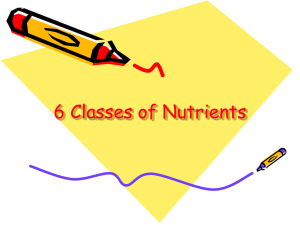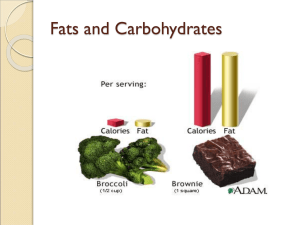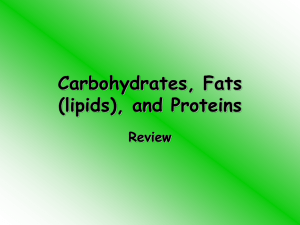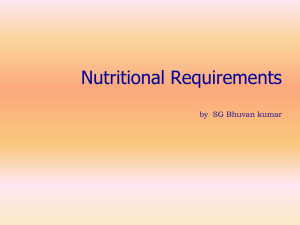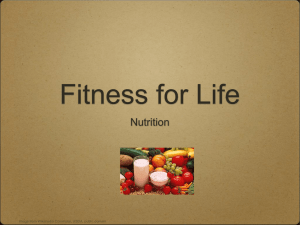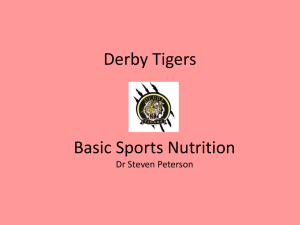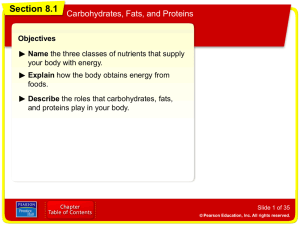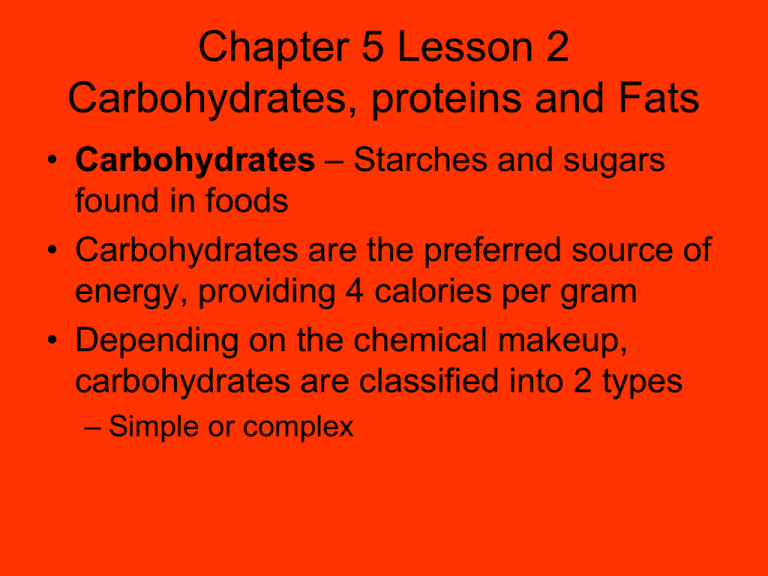
Chapter 5 Lesson 2
Carbohydrates, proteins and Fats
• Carbohydrates – Starches and sugars
found in foods
• Carbohydrates are the preferred source of
energy, providing 4 calories per gram
• Depending on the chemical makeup,
carbohydrates are classified into 2 types
– Simple or complex
Carbohydrates
• Health experts recommend that 55 to 65%
of your daily calories come from
carbohydrates, mainly complex
carbohydrates
Simple Carbohydrates
• Sugars are present naturally in fruits,
some vegetables, and milk
• Fructose – Fruits
• Lactose – Milk
• Maltose – grain
• Sucrose – Table sugar
Complex Carbohydrates
• Starches – found in great supply in rice and
other grains, seed nuts, legumes (dried peas
and beans)
• Tubers – (potatoes, cassava, yams, taro)
• Starches are called complex carbohydrates
because they are chemically more complex than
simple carbohydrates
• During digestion, starches break down into
sugar
The Role of Carbohydrates
• Before body can use carbohydrates it
must be broken down into glucose
• Glucose – a simple sugar and IS THE
BODY’S CHIEF FUEL
• Glucose not used right away is stored in
the liver and muscles as a starch like
substance Called GLYCOGEN
The Role of Carbohydrates
• Later when glucose is needed the
glycogen is converted back to glucose
• When people consume more
carbohydrates than their body need for
energy or can store as glycogen, this
excess is stored as adipose tissue or fat
Fiber
• Found in the tough, stringy part of
vegetables, fruits, and grains, fiber is a
special for of complex carbohydrate
• It cannot be digested or used for energy it
helps move waste through your digestive
system
Fiber
• Helps reduce some types of cancer
• Helps reduce constipation, appendicitis
• Helps control diabetes and some types of fiber
seem to help lower blood cholesterol
• Increase fiber in body by eating an abundance
of fruits and vegetables
• Bran cereal, wheat breads, pasta, oatmeal,
brown rice, popcorn
• Need 25 grams of fiber per day
• Special form of Complex carbohydrates
Proteins
Proteins
• Nutrients that help build and maintain body
tissues
• Muscle, bone, skin, connective tissue,
teeth, blood and vital organs all contain
protein
• Calories provide 4 calories per gram
• Excess protein is converted to fat and
stored for storage
Proteins
• Proteins are made of building blocks
called AMINO ACIDS
• Your body can make all but 9 of the 20
amino acids
• These 9 are called ESSENTIAL AMINO
ACIDS because they must come form food
you eat
• Proteins – 2 categories – Complete and
Incomplete
Complete Proteins
• Complete proteins – Contain all essential
amino acids that come from food you eat
that the body needs and in the proper
amounts
• These include animal products, such as
fish, meat, poultry, eggs, milk, cheese,
yogurt, and many soybean products
Incomplete Proteins
• Foods that lack some of the essential
amino acids
• Such food sources come from plants:
• Legumes, nuts, whole grains, and seeds
• Eating various incomplete protein sources
– Legumes with grains give the
equivalent of a complete protein
• P.104
The Role of Proteins
• During life new proteins form constantly to
replace damage or worn out body cells
• Proteins in enzymes, hormones and
antibodies also help regulate many body
processes
Fats
Fats
• Fats are a type of lipid – a fatty
substance that does not dissolve in
water
• Fats are composed of carbon, hydrogen,
and oxygen atoms
• Fats are made of fatty acids
• Fats classified as SATURATED OR
UNSATURATED
Fats
• Gram for gram, fats deliver more than
twice the energy of either carbohydrates or
proteins
Saturated Fats
• Fatty acids are called saturated when the fatty
acid hold all the hydrogen atoms it can
• Saturated Fats: Stay solid or semi solid at
room temperature
• Animal fats and tropical oils
–
–
–
–
Palm oils
Palm kernel oil
Coconut oil
Fats in beef, pork, egg yolks, and dairy foods
Unsaturated Fats
• When fatty acid is missing one or ore pairs
of hydrogen atoms
• Most vegetable fats are unsaturated:
Liquid at room temperature
• Olive oil, canola soybean, corn, cotton
seed oils are unsaturated
• *Hydrogenated foods – adding missing
hydrogen atoms to food - PEANUT
BUTTER, MARGARINE
The Role of Fat
• Fats carry vitamins A,D,E,K into your
blood stream and serve as sources of
linoeic acid – Essential fatty acid not
made in the body but which is essential for
growth and healthy skin
• Body fat surrounds and protects vital
organs
• Protects body against excessive heat or
cold
The Role of Fat
• Body needs only a moderate amount of
dietary fat each day
• Average teenage girl: 2,200 calories per
day and 66 grams of fat per day
• Average teenage boy: 2,800 calories per
day and 84 grams of fat per day
• Too much fat linked to obesity, heart
disease, diabetes
• Fat intake no more than 30% daily
Cholesterol
• Fatlike substance produced in the liver of
all animals and therefore, found only in
foods of animal origins – meats, poultry,
fish, eggs and dairy products
• Cholesterol is instrumental in production of
sex hormones, vitamin D and protective
sheaths around nerve fibers


